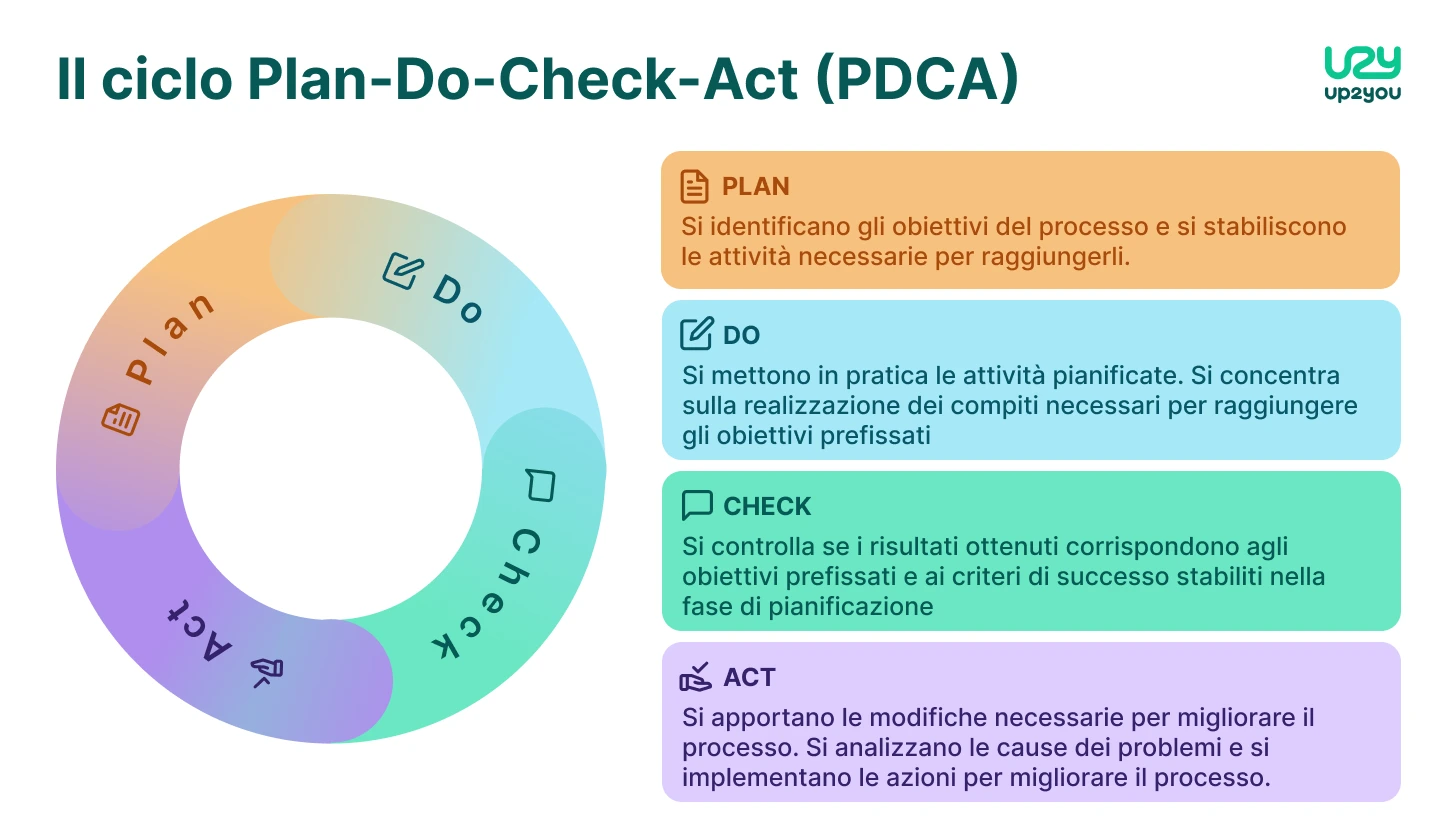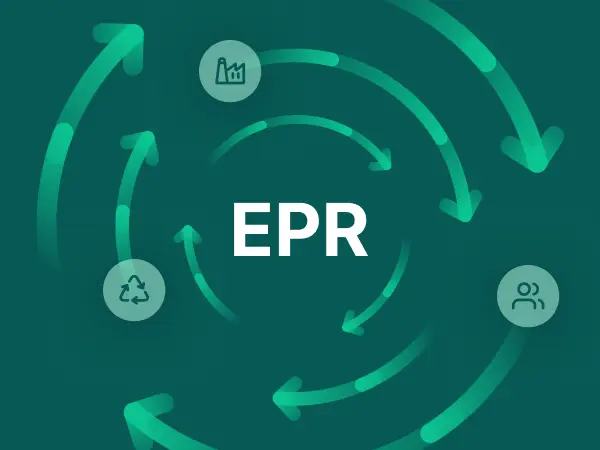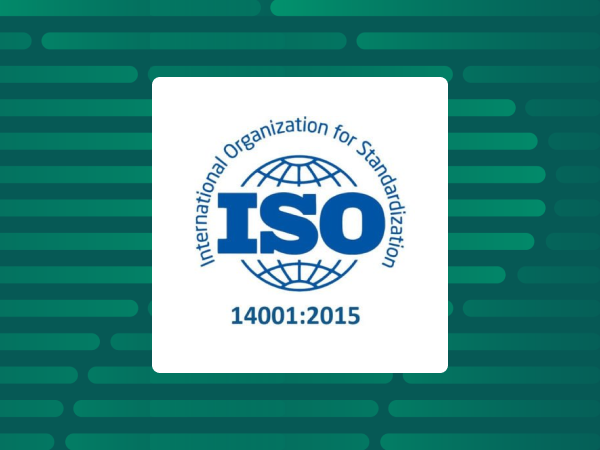{summary#bullet-1}
What is the ISO 14001
The ISO 14001 It's a sustainability certification recognized globally that defines the requirements to implement a Environmental Management System (EMS) effective.
The objective of the standard is to help organizations, public and private, of any sector and size, to identify, control and reduce their environmental impacts, in a structured and continuous way.
Based on the continuous improvement cycle Plan-Do-Check-Act (PDCA), ISO 14001 guides organizations through a path that starts from planning their environmental policy and the objectives to be achieved, and then moves on to their implementation, monitoring and review. This approach makes it possible to improve progressively environmental performance, adapting them to the specific context and to the expectations of the interested parties.
In addition to supporting the regulatory compliance, helping companies to comply with current environmental laws, ISO 14001 allows them to manage risks and seize opportunities related to sustainability. It's a Voluntary standard, but highly strategic for all those companies that want to demonstrate a concrete commitment to the environment.
ISO 14001 is designed to be can be integrated with other management standards, such as ISO 9001 (quality), ISO 45001 (health and safety) or ISO 50001 (energy). In addition, its requirements are fully compatible with the EMAS regulation (Reg. CE n. 1221/2009) that allows organizations to commit to evaluating and improving their environmental performance.
Adopting ISO 14001 means having a concrete instrument to promote a concrete corporate sustainability, improving the company's reputation, operational efficiency and dialogue with stakeholders who are increasingly sensitive to themes ESG.

{summary#bullet-2}
Who can benefit from ISO 14001 certification?
ISO 14001 is aimed at any organization that intends to manage in a structured and aware their environmental impacts, regardless of size, sector or legal nature. This is one universal and flexible standard, applicable both to multinationals and to SMEs, artisan businesses, public bodies and third sector realities.
It is particularly common in contexts such as high environmental impact, such as:
- manufacturing and processing industry;
- construction and infrastructure sector;
- logistics and transport;
- environmental services and waste management.
In recent years, however, its adoption has also extended to less traditional areas, such as that of services, tourism and public administrations, driven by the growing attention to sustainability, environmental regulations and ESG criteria.
The ISO 14001 certification therefore represents a Strategic lever for all those organizations that want to:
- reduce environmental risks related to its activities;
- improve legislative compliance;
- increase trust on the part of customers, investors and stakeholders;
- make your business model more competitive and sustainable;
- demonstrate your commitment to environmental management in public tenders or tenders;
- qualify as a supplier to companies with environmental sustainability requirements.
{summary#bullet-3}
How to obtain the ISO 14001 certification
Obtaining ISO 14001 certification means undertaking a structured path, which allows the organization to demonstrate the effective implementation of a Environmental Management System (EMS) complies with international standards.
However, before involving the certifying body and starting auditing activities, the company must build internally the operational and documentary foundations of the system itself.
In this preparatory phase, the organization is called upon to:
- define your environmental policy, formalizing commitments and values in the field of sustainability and environmental management;
- identify environmental aspects, systematically evaluating the impacts of its activities, products and services on the environment;
- Establish improvement objectives and actions, in line with their strategic priorities and with the results of the impact analyses;
- Concretely implement the Environmental Management System, through the introduction of procedures, roles, processes and operational tools for monitoring and continuous improvement.
Only after these preparatory phases, the organization can start the certification process, relying on a accredited third party. This process, divided into 5 steps, is designed to ensure transparency, reliability and continuous improvement.
1. Preliminary analysis (optional)
Upon request, it is possible to initiate a pre-audit: a preliminary check useful to assess the organization's level of preparation and to identify any gaps to be filled before the official audit.
2. Data collection and technical-economic proposal
The organization fills out an information questionnaire that allows the certifying body to formulate a technical and economic offer. Once accepted, it constitutes the contract for starting the certification.
3. Initial Audit
The audit process generally takes place in two phases:
- Phase 1: evaluation of the documentation and basic requirements of the environmental management system.
- Phase 2: in-depth verification of the actual application of the system and its compliance with the ISO 14001 standard.
4. Issuance of the certificate
At the end of the audit, the institution issues a detailed report. If the system is compliant, the documentation is reviewed by a technical committee, which approves the issuance of the ISO 14001 certificate of compliance.
5. Maintenance and continuous improvement
The certificate is valid for three years, but includes annual surveillance audits to monitor the evolution of the system, verify its effectiveness and support continuous improvement. At the end of the three-year period, it is possible to renew the certification through a new evaluation.
At Up2You, we support you right from the preparatory phase, helping you organize activities, processes and documentation necessary to build a solid system ready for certification. We can also support you throughout the certification process, to accompany you step by step towards obtaining the ISO 14001 certificate.
{summary#bullet-4}
Who issues ISO 140001
The ISO 14001 certification is issued by accredited certification bodies, i.e. independent third parties responsible for evaluating whether an organization has implemented an Environmental Management System (EMS) that complies with the requirements of the standard. These bodies operate under the control of accreditation bodies, which guarantee its competence, impartiality and compliance with international standards.
In Italy, the accreditation is entrusted to Accredia, the only national body recognized by the State. Only certifying bodies accredited by Accredia can issue valid and internationally recognized ISO 14001 certifications.
The choice of the certifying body is a strategic step: it not only establishes the compliance with the standard, but it also reinforces the credibility of the organization's environmental commitment in the eyes of customers, stakeholders and the market. In Up2You we can support you during this phase, so that you can choose the most suitable certification body for your company.
{summary#bullet-5}
How much does it cost to obtain ISO 14001
The cost of obtaining ISO 14001 certification may vary significantly based on various factors related to the characteristics and complexity of the organization.
Understand in advance the main items of expenditure make it possible to plan the investment in a conscious and sustainable way. The elements that have the greatest impact on costs include:
- The size of the company (the larger the structure, the greater the processes and environmental aspects to be analyzed);
- the sector of activity (sectors with a high environmental impact or subject to complex regulations such as chemistry, construction or manufacturing require more in-depth checks);
- the number of offices or establishments to be certified (the presence of more operating units requires more complex audits).
Indicatively, the total costs of obtaining ISO 14001 certification can be divided into two categories main:
- costs for advice and support in the construction of the Environmental Management System (EMS);
- certification costs by the accredited third party.
La first category Of costs it is optional: an organization that has internal skills and resources can choose to independently develop the path that will lead it to certification. However, rely on a experienced partner can greatly facilitate all preparatory phases, reducing time and complexity.
Up2You, for example, supports companies in the design and complete implementation of the Environmental Management System. Thanks to theconsolidated experience with numerous certifying bodies and the use of proprietary platforms, it is possible to simplify the entire process, optimizing data collection and improving document and operational management.
La second category Of costs, on the other hand, concerns theexternal certifying body, which has the task of evaluating the compliance of the implemented system with respect to the requirements of the standard. This is a mandatory cost in order to obtain ISO 14001 certification.
The certification issued is then valid for Three years. During this period, it should be considered the annual maintenance cost, linked to surveillance audits that the organization must support during the entire three-year validity cycle of the certification. At the end of the three-year period, there is a full recertification audit, necessary to renew the validity of ISO 14001 and demonstrate the continuous commitment to improving environmental performance.
Even during the certification phase it is possible to be supported by specialized companies that support the organization in operational management and in relations with the third party. Up2You, in this context, can guarantee a full accompaniment thanks to its digital solutions, which allow efficient data collection consistent with what was already developed in the preparatory phase.
{summary#bullet-6}
The 6 advantages of obtaining ISO 14001 certification
Obtaining ISO 14001 certification represents a concrete step towards a more sustainable, efficient and competitive management model. This is a strategic choice that allows you to enhance environmental commitment of the organization and, at the same time, to generate a competitive advantage compared to the competition.
Let's see what are the six main advantages associated with the adoption of a certified Environmental Management System.
- Continuous improvement of environmental performance
ISO 14001 provides a clear and structured framework for monitoring, controlling and reducing environmental impacts throughout the lifecycle of products, services and processes. It makes it possible to prevent pollution, reduce waste, unwanted emissions and waste, promoting a more rational use of natural resources. - Economic savings and greater operational efficiency
The adoption of good environmental practices brings concrete economic advantages: lower energy consumption, reduction of waste, optimization of processes and containment of operating costs. - Easy access to tenders, contracts and incentives
Certification is often considered a rewarding requirement in calls for tenders, public funding or environmental concessions. In some sectors, such as waste treatment or quarrying, it is even required as a regulatory prerequisite. - Regulatory compliance and legal risk reduction
ISO 14001 supports the organization in maintaining compliance with current environmental regulations, reducing the risk of sanctions, litigation and reputational damage. In addition, it favors an orderly management of emergencies and a preventive approach to environmental crimes. - Strengthening the reputation and trust of stakeholders
Certification is a strong and verifiable sign of the company's environmental commitment, which improves perception by customers, investors, partners and authorities. Communicating sustainability in a credible and certified way reinforces corporate identity and ESG positioning. - Support for strategic decisions and protection of business value
A well-managed environmental system offers useful tools to guide investments, innovations and decision-making processes in a sustainable way. Furthermore, in the case of extraordinary transactions (mergers, acquisitions), it represents an element of transparency and protection of corporate assets.






























